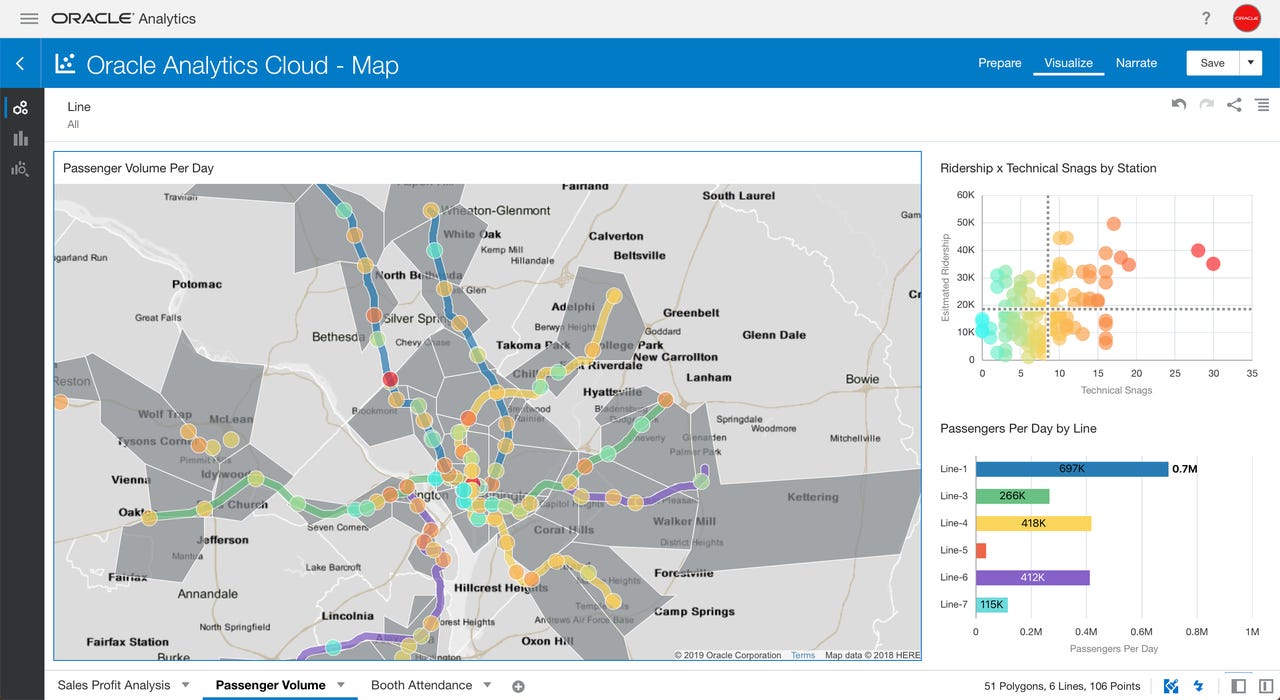Oracle Analytics: Honing 18+ products down to a single brand


An Oracle Analytics Cloud map visualization, accompanied by scatter plot and bar chart
Long one of Enterprise BI's elders, Oracle's business intelligence stack has grown through evolution, acquisition and partnerships. This has made for a complex set of offerings and a price list that's been far from straightforward. But at its Oracle Analytics Summit at Skywalker Ranch in Marin County, CA today, Oracle is announcing simplified branding and packaging for its analytics products and services.
From now on, "Oracle Analytics" will be the parent brand for all new Oracle BI and data analytics products. While the older Oracle Business Intelligence Enterprise Edition (OBIEE) and Hyperion Enterprise Performance Management (EPM) products will remain present and supported, all new investment and action will be on the Oracle Analytics front.
Break it down
New sheriffs in town Bruno Aziza (Group Vice President, AI, Data Analytics and Cloud) and T.K. Anand (Senior Vice President, Analytics Cloud), both veterans of Microsoft's BI organization, explained to me how the new branding and product taxonomy will work, with Oracle Analytics breaking down into three pillars:
- Oracle Analytics Cloud will encompass all stand-alone cloud analytics and will serve as the flagship offering
- Oracle Analytics Server encompasses all stand-alone on-premises analytics, and is essentially a reboot of OBIEE
- Oracle Analytics for Fusion Applications will cover analytics in service of Oracle's many business applications
Oracle explains that products in all three pillars leverage both classic analytics capabilities as well as new features, including augmented analytics and natural language processing (NLP). (See Oracle's business analytics roadmap here.) Oracle says it also now offers an integrated user experience across self-service data discovery and reporting & dashboards, be it on the cloud, desktop or mobile device.
Analytics fusion
Oracle Analytics for Fusion Applications bears further explanation. First off, realize that in addition to its BI offerings and its core database products, Oracle is a major business applications company, with an array of products under its Fusion Applications umbrella. This portfolio consists of Oracle's homegrown ERP and financial applications as well as products acquired over the years from Peoplesoft (ECM), Siebel (CRM), JD Edwards (more ERP), Hyperion (Enterprise Performance management -- EPM) and Netsuite (cloud-based mid-market business applications).
Architecturally, Oracle Analytics for Fusion Applications will be based on Oracle Analytics Cloud as well as Oracle's Autonomous Data Warehouse (ADW). But, unlike those services, Oracle Analytics for Fusion is a Software as a Service (SaaS) offering, rather than a Platform as a Service (PaaS) offering. Data from Oracle ERP/HCM/CRM applications is pipelined into a predefined star schema-based semantic model, in Oracle Analytics for Fusion, automatically.
Analytics logistics
The semantic model includes dimensions that span across applications and application categories; no custom ETL is required and the pipelining runs implicitly and silently in the background. Users can utilize Oracle's own query and visualization tooling but can also connect to it from standard tools, including most BI tools and Microsoft's Excel. Power users and developers can even query the Oracle Analytics for Fusion Applications semantic model directly, via SQL.
More bespoke analytics can be co-located on Oracle Analytics for Fusion Applications infrastructure, while still being billed on Oracle Analytics Cloud's PaaS basis, based on Oracle Universal Credits. That monthly pricing can be either $20 per user or $2,000 per-Oracle CPU (OCPU -- essentially core-based), suiting departmental and Enterprise usage scenarios, respectively.
When it comes to cloud analytics, Oracle's got a lot of catching up to do, both in terms of adding capabilities, as well as messaging and evangelizing the under-promoted capabilities already present in the platform. On the other hand, Oracle's got lots of Enterprise customers on its analytics stack and, for a variety of reasons, they're unlikely to bolt anytime soon. That gives Oracle time to do its homework and modernize, something today's announcements would seem to corroborate.
Updated at 11:13am ET on July 6th, 2019 to clarify that $20 monthly user and $2000 monthly OCPU pricing applies to Oracle Analytics Cloud and not Oracle Analytics for Fusion Applications.